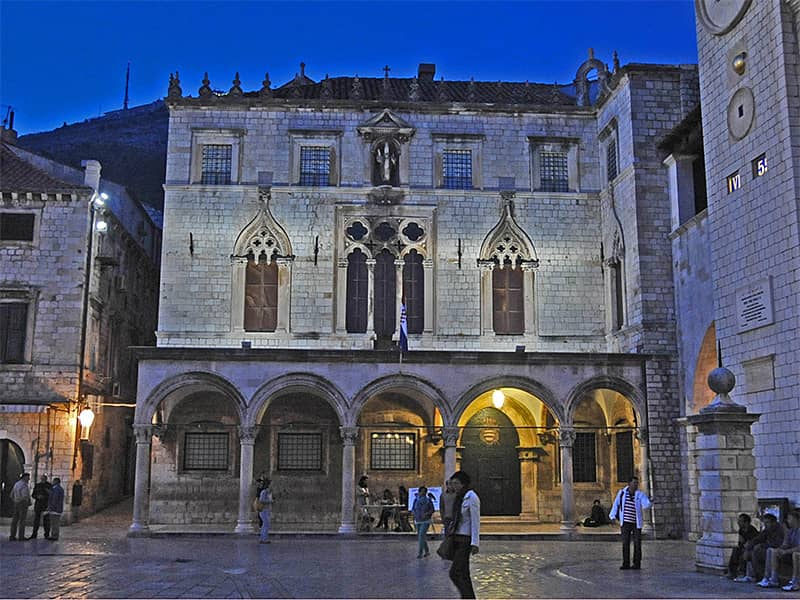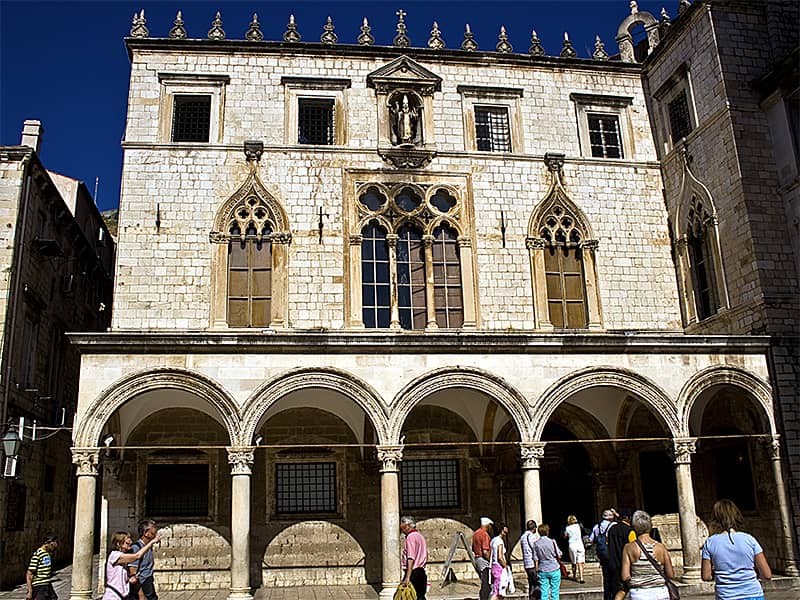Check out the real-life Dubrovnik monuments, attractions and beautiful sights. Many were used for Game of Thrones film sites in and around Old Town Dubrovnik. Discover many other exciting experiences and attractions in Dubrovnik, check out The best things to do in Dubrovnik.
Franciscan Monastery
Franciscan Monastery is built in the transitional Romanesque-Gothic style. The construction started in 1337. In 1667 it was completely destroyed in the Great Earthquake. The door with Pieta at Stradun is the only thing left from the original church after it has been rebuilt. The Cluster of the Franciscan Monastery is considered to be a masterpiece of architecture in Dubrovnik. It was built in Romanesque-Gothic style by the famous Mihoje Brajkov from Bara. The capitals are a true example of Romanesque style, with bestiary motives bringing the spirit of Gothic as well.
Dubrovnik Super Saver:
Cable Car Ride and Old Town Walking Tour plus City Walls
Discover the charm and history of Dubrovnik on this unforgettable journey. Explore the UNESCO World Heritage Site of Dubrovnik Old Town's narrow and winding streets, and admire the mesmerising views from the 16th-century city walls. Take your experience to new heights with a cable car ride to Mt. Srđ for panoramic views. Book your tour now with a knowledgeable expert.
Pieta at the church of Male brače - gothic sculpture done by Leonard and Petar Petrović (1498). The lofty interior of the monastery (reputed once to have had ceiling paintings by Titian) was reconstructed after the Great Earthquake of 1667.
The Old Pharmacy, located inside the Franciscan monastery, was opened in 1317. It is the third oldest pharmacy in Europe, but the only one still working. The inventories, ceramics, bowls, laboratory equipment and old medical books of the old Pharmacy are kept in the Franciscan Monastery Museum, among other highly valued and priceless objects of Dubrovnik's historic and cultural past.
The Franciscan monastery's library possesses 30,000 volumes, 22 incunabula, 1,500 valuable handwritten documents. The well-labeled exhibits include a 15th century silver-gilt cross and silver thurible, an 18th century crucifix from Jerusalem in mother-of-pearl on olive wood, an martyrology (1541) by Bemardin Gucetić (Gozze) and illuminated Psalters.
Among the pictures is one of Ruđer Bošković painted in London in 1760, and a painting showing the town before the earthquake. This painting is one of the very few ones that show the Old Town before the earthquake and is used to reconstruct and understand how Dubrovnik was build before the catastrophe in 1667.
Location
Placa 2, 20 000 Dubrovnik
Opening hours / Price
9 am -6 pm, entrance fee: 30 kn, children 15 kn
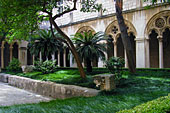
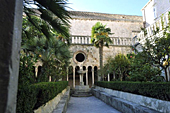
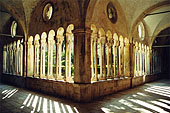
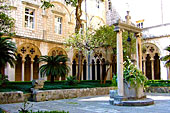
Church of the Holy Savior
The Church of the Holy Savior is located on the left after entering Old Town Dubrovnik from Pile Gate. It is the first church at the main street Stradun. The Andrijići brothers, domestic master builders from Korcula, build the church between 1520. and 1528. by the Dubrovnik Senat's gratitude. The church has typically Dalmatian Renaissance wheel-window front and Gothic interiors. Inside the church there is a magnificent painting of the Ascension by Pietro Antonio da Urbino (1528).
This small votive church, according to the decision by the Dubrovnik Senate, was built as a sign of gratitude for the salvation from the earthquake which struck the same year. In the 1667. earthquake, the church remained undamaged, and has been preserved to the present day in its original decor.
With the construction of this lovely little church with its decorative facade, they left behind yet another pearl of Dubrovnik Renaissance architecture.
Location
Poljana Paska Miličevića, 20 000 Dubrovnik
Opening hours / Price
9 am -6 pm, entrance fee: 30 kn, children 15 kn
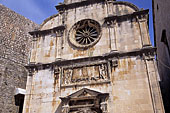
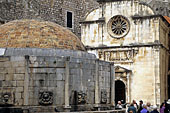
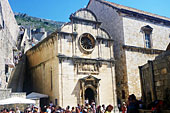
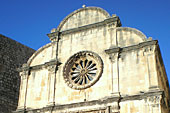
Stradun (Placa)
The main street in Old Town Dubrovnik is called STRADUN or PLACA. It is a, approximately 300 meter long, pedestrian zone and it runs from the Pile to Ploče gates, following the line of the channel that once divided the town into two parts. The street came into being in the 12th century, was paved in 1468. and reconstructed after the earthquake of 1667. The limestone pavement, polished by use, shines like glass after rain.
The houses on each side, though preserving an ancient ground plan, also date from the 17th century, their elevation and style being uniform. Their shops mostly have the characteristic "na koljeno" combined door and counter. The "na koljeno" type consists of a door and window in a single frame spanned by a semicircular arch. The door was kept closed and goods handed over the sill, which served as a counter.
Location
Placa, 20 000 Dubrovnik
Opening hours / Price
24 hours, free
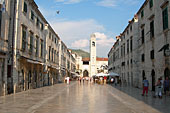
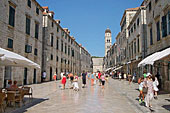
Pile Gate
At the entrance gate to the Old Town from the west there is a stone bridge within two Gothic arches, designed by Paskoje Miličević (1471). That bridge ends at another bridge, wooden drawbridge which used to be pulled up every evening. Above the bridges, over the arch, the statue of city patron St. Blaise (Sv. Vlaho) is set.
Location
Pile Gate Old Town Dubrovnik entrance, 20 000 Dubrovnik
Opening hours / Price
24 hours, free
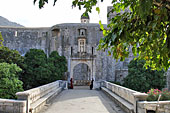
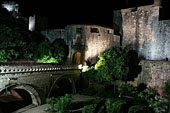
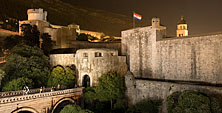

Big Onofrio's Fountain
Located at the open space right after passing Pile gate and entering the main street of Old Town Dubrovnik. It is a 16-sided drinking fountain built by Onofrio de la Cava (1438. - 1444.). The Fountain is part of the town's water supply system which Onofrio managed to create by bringing the water from the well in Rijeka Dubrovačka. The well is located 20 km from Big Onofrio's Fountain and this construction was a masterpiece of that time.
In 1436. the Dubrovnik Republic concluded a contract with the Neapolitan architects Onofrio della Cava and Andriuzzi de Bulbito about the construction of a water supply system inside the Old Town. The first part of that project was already completed in 1438, and Onofrio continued working on it until he left Dubrovnik in 1443. Onofrio's Large Fountain was sculpted and decorated after Onofrio's project by Petar Martinov from Milan and local artisans.
The fountain suffered heavily in the 1667 earthquake when almost all decoration was damaged except 16 stone-carved water openings called maskerons.
Location
Poljana Paska Miličevića, 20 000 Dubrovnik
Opening hours / Price
24 hours, free
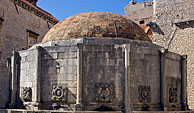
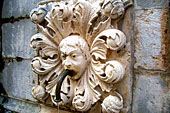
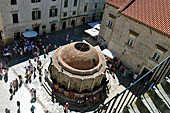
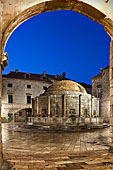
Small Onofrio's Fountain
Built by Petar Martinov in 1441 in the shape of an octagonal basin with defaced sculptural panels, from which rises a 'baroque-Gothic' column recalling the fountains of Viterbo.
Location
Poljana Paska Miličevića, 20 000 Dubrovnik
Opening hours / Price
24 hours, free
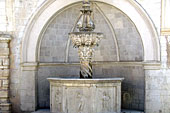
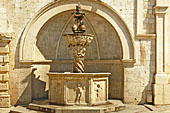
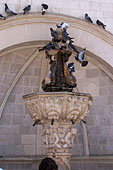
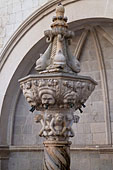
Dubrovnik City Walls
The City Walls are among the finest and most complete in Europe. They protected the freedom of Dubrovnik Republic for centuries. They surround the entire Old City with their 1940 meters of length and up to 25 meters of height. The whole City Wall complex was built from the 8th until the 16th century, consisting of an inner and outer section. There are five bastions, 3 circular and 12 square and rectangular towers, two corner towers, and one huge fortress. The outer section of City Walls consists of a lower wall, having 10 semicircular bastions built by the famous Italian architect Michelozzo. The town is defended by two more separate fortresses, at Revelin on the eastern side and Lovrijenac on the southwest side. The moat ran around the outside section of the City Walls.
Combine visiting Dubrovnik City Walls with Old Town walking tour and Cable Car ride: Check availability and prices
Location
Old Town Dubrovnik, 20 000 Dubrovnik
Opening hours / Price
08:00 - 19:00, from 35 Eur for adults, children up to 18 years 15 Eur
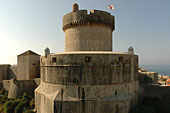

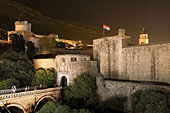

Fortress Minčeta
The most massive tower within the Old Town, located at the north side of the City Walls, provides one of the finest views to the city, its streets and buildings. It is the architectural work of Ranjina, Michellozzo Michellozzi, and was finally finished by Juraj Dalmatinac. At first it was a smaller square-shaped building, later on some parts were added, finally receiving its current look in 1464. Some Summer Festival performances take place at the terraces of this magnificent historical monument.
Combine visiting Fortress Minčeta with Dubrovnik City Walls, Old Town walking tour and Cable Car ride: Check availability and prices
Location
Minčeta Tower Old Town Dubrovnik, 20 000 Dubrovnik
Opening hours / Price
08:00 - 19:00, from 35 Eur for adults, children up to 18 years 15 Eur
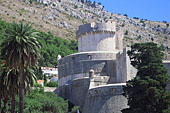
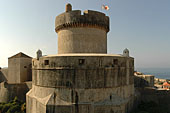
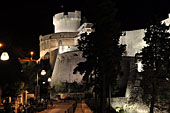
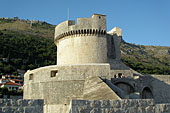
Ploče Gate
Entrance gate to Old Town Dubrovnik from the East. Outer Ploče Gate is built by Miho Hranjac in 1628., while the wooden drawbridge and twin-spanned stone bridge (15th C) by Paskoje Miličević are similar to those at Pile Gate. Over the bridge there is the statue of St. Blaise, the patron of Dubrovnik. It has inner and outer sections, while the approach is via a stone bridge. Built into Ploče's outer section is Revelin Fortress, that used to serve as a lookout point.
Location
Ploče Gate Old Town Dubrovnik, 20 000 Dubrovnik
Opening hours / Price
24 hours, free
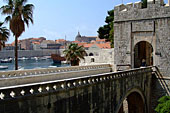
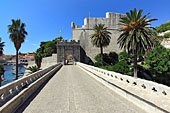
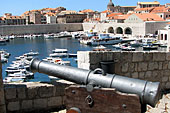
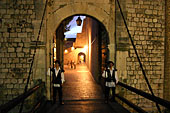
Fortress St. Ivan
Located at the south part of the City Walls, served as the protector of the City Harbor. It was erected in four stages between 1346 and 1557. Its final look dates from the 16th century. During night the city harbor was closed with a chain which was stretched from St. Ivan fortress to Kaše - the breakwater built in 15th century. Today, St. Ivan Fortress hosts three museums.
On the ground floor is the Aquarium, stocked with fish from various parts of the Adriatic Sea. On the upper floors are the Ethnographic Museum and a Maritime museum in which four sections are devoted to the Dubrovnik Republic maritime period, the age of steam, the Second World War and to the techniques of sailing and navigation.
Location
Fortress St. Ivan Old Town Dubrovnik, 20 000 Dubrovnik
Opening hours / Price
08:00 - 19:00, from 35 Eur for adults, children up to 18 years 15 Eur
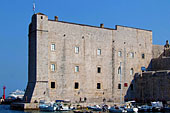
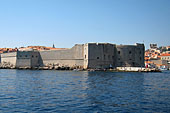
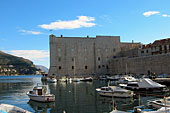
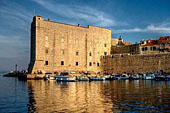
Fortress Revelin
Built in the 16th century (1500 - 1538) at the eastern side of the city, outside the city walls, in the form of an irregular square. It was designed by the architect Anton Ferramollino. The fortress was built to protect the City Harbor, Ploče Gate, and the City Bridge. Its enormous terrace also makes a fine natural stage for performances in summer.
Location
Ul. Svetog Dominika, 20 000 Dubrovnik
Opening hours / Price
08:00 - 19:00, from 35 Eur for adults, children up to 18 years 15 Eur
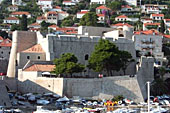
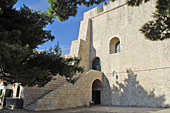
Fortress Lovrijenac
Located at the western side of the Town outside the City Wall at a 36 meters high cliff. It dominates, both the sea and the land entrances to the Town from the west. According to old scripts it was built in only three months. Today its interior is one of the most dignified stages in Europe, a well-known place for Shakespeare's Hamlet performances.
Fort Lovrijenac was used as one of Game of Thrones, King's Landing filming locations and settings in Dubrovnik.
Location
Ul. od Tabakarije 29, 20 000 Dubrovnik
Opening hours / Price
08:00 - 19:00, from 35 Eur for adults, children up to 18 years 15 Eur
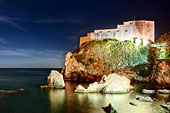
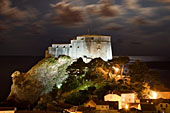
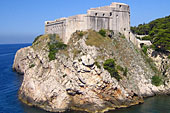
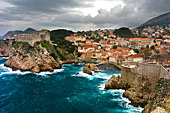
Palace Sponza
Throughout the times of the Dubrovnik Republic it had different purposes and was used as a custom house, a mint and main warehouse ( known at different times as the Pontik, Divona or Dogana). Sponza was one of the more important buildings in the city and remained in continuous public use until the end of the 19th C. Sponza was designed by Paskoje Milièević, built by Petrović, Radivojević, and the Andrijići brothers (1516-1522). It represents a harmonious blend of Gothic and Renaissance architecture; at the ground floor there are monumental renaissance arcades; at the first floor we find elegant gothic monofores and trifores; the second floor is decorated with Renaissance windows, while the roof is built in Gothic style.
The interior of Sponza consists in a round and spacious court, arranged as a double cloister, with round arches below and slightly pointed arches on the first floor. The first floor was used for social gatherings and meetings of learned and literary societies. The ground floor houses exhibitions of artists and festival concerts and contains the original 16th C mechanism that controls the town bell and clock (called Zelenci - Maro and Baro).
Location
Stradun 2, 20 000 Dubrovnik
Opening hours / Price
08:00 - 20:00, free
